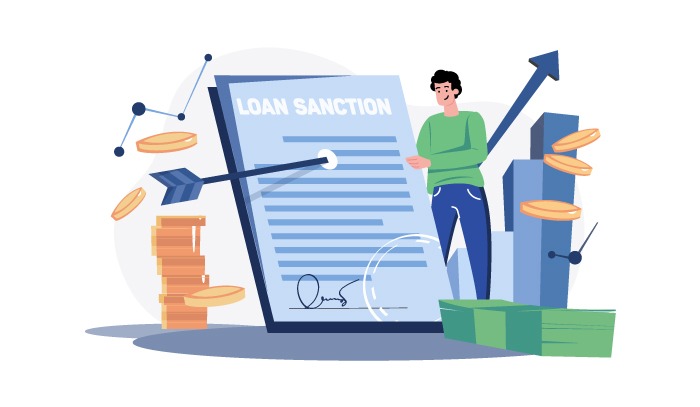SME Loan
How to Read or Decode SME Loan Sanction Letter
Decoding SME Loan Sanction Letter
A sanction letter is a formal document issued by a financial institution, such as a bank or lender, confirming their approval to grant a loan to an individual or entity. This letter outlines the terms and conditions of the loan, including the loan amount, interest rate, repayment schedule, and any other relevant details.
Decoding a sanction letter involves understanding the key information provided in the document. Here are the typical components of a sanction letter and how to interpret them:
Points to Review in the Sanction Letter
A. Sanctioned Amount and Type of Loan
- Check the type of facilities applied for, including Fund-Based and Non-Fund-Based limits, and verify the sanctioned loan amount.
a. Fund-Based Facility:
- Term Loan
- Cash Credit or Overdraft
- Finance for Inland Bill Purchase & Bill Discounting
- Export Packaging Credit Facility
- Loan against property (LAP)/ Housing Loan
- Loans against Securities
- Loans against fixed deposits
b. Non-Fund Based Facility:
- Bank Guarantee:
- Performance Bank Guarantee: Ensures compensation in case of inadequate or delayed performance on a contract.
- Financial Bank Guarantee: Ensures debt repayment in case of borrower default.
- Letter of Credit: Both Domestic LC and Import LC for procurement of goods and/or fixed assets.
B. Applicable Rate of Interest/Commission
- The bank may charge either a Fixed or Floating rate of Interest.
- Fixed Rate of Interest: Remains constant throughout the loan tenure.
- Floating Rate of Interest: Changes based on the lender’s benchmark rate. Check the reset frequency.
C. Loan Repayment Tenure
- Review the repayment period and moratorium period. (In the moratorium period, only interest is to be paid).
- Verify the number of instalments and payment frequency (e.g., monthly, quarterly).
- Check if the repayment is through equal EMI or if there is a ballooning repayment schedule.
D. Processing Fees and Other Charges
- Common charges include Processing Fees, Documentation charges, Franking Charges on Mortgage deed, Hypothecation deed, and other legal documents.
- Verify renewal fees, stock audit fees, etc., in case of Cash Credit.
- Check CGTMSE fees (if applicable).
E. Prepayment Charges & Takeover Charges
- Prepayment Charges: Fees paid to the bank if the loan is prepaid before its term ends. Verify the charges and their applicable period.
- Takeover Charges: Levied if the loan is taken over by another Financial Institution. Check for any takeover charges.
F. Purpose of Loan
- Verify the sanctioned purpose of the loan and any restrictions on using funds for purposes other than what is specified.
G. Margin Money
- Check the margin money requirement, which is the amount brought into the business through long-term sources of finance. It’s essential to understand the industry’s trend for margin requirements.
H. Security Details (Primary and Collateral)
- Primary Security: Assets directly associated with the business for which the credit facility is extended (e.g., Stock and Book debts for Working Capital Facility).
- Collateral Security: Assets accepted by the lender as security for the loan (usually immovable property).
- Verify the Debt Service Reserve Account (DSRA) requirement.
I. Collateral Coverage
- Review the security coverage ratio and ensure it aligns with the valuation of securities offered for the loan.
- Check for conditions requiring additional security, such as immovable property or liquid security (FDs, Mutual Funds, Debts Funds, LIC), in case of a shortfall in Collateral Coverage.
- Consider if the loan is sanctioned under the CGTMSE Scheme.
J. Valuation and Title Report
- Verify the number of valuers and advocates from whom Valuation and Title Reports are to be obtained.
- Usually, two registered valuers provide reports, and the lower of the two values is considered for calculating Collateral Coverage Ratio.
K. Types of Charge
- Understand the types of charge involved, such as Hypothecation, Mortgage, and Pledge, and their implications.
L. Guarantee
- Check for Personal Guarantees (e.g., Promoters) and Corporate Guarantees, if applicable.
M. Financial Covenants
- Ensure compliance with financial covenants mentioned in the Sanction Letter, such as EBITDA margin, DSCR, Debt/EBITDA, Debt/Tangible net worth, etc.
N. Validity of Sanction Letter
- Verify the validity period of the sanction letter, typically six months.
O. Pre-Disbursement Conditions
- Check various pre-disbursement conditions, including insurance requirements, external credit rating, GPCB consent, power connection, CA certificates, and due diligence reports.
P. Post-Disbursement Conditions
- Verify post-disbursement conditions, including the end use of funds certificate, account details, ROC charge filing, and more.
Q. Timeline of Disbursement of Loan
- Understand the timelines for security creation and documentation and the expected disbursement date.
It’s essential to thoroughly read and understand all the terms and conditions mentioned in the sanction letter. If there are any unclear or confusing aspects, it’s advisable to seek clarification from the lender before proceeding with the loan. Additionally, consulting with a financial advisor can be beneficial to ensure a clear understanding of the implications of the terms outlined in the sanction letter. Unlock the fast track to SME success! Learn the ropes of applying for an SME loan and securing it within 48 hours. Connect with us at 1800 309 8010 or visit https://ratnaafin.com/business-loan/ for a seamless journey to business growth.
More Articles

SME Loan 11:18 AM
What is an MSME in India?Ready to unlock the potential for your dreams?
Demystifying MSME or SME Loan Options (Variants, Tenure, Rates, and Use Cases)
In the dynamic landscape of today’s business world, small and medium-sized enterprises (SMEs) play a crucial role in driving economic growth and innovation. However, these businesses often face financial challenges that hinder their expansion and operational efficiency. To address these challenges, financial institutions offer a range of loan options tailored specifically for Micro, Small, and Medium Enterprises (MSMEs). In this comprehensive guide, we will delve into the various facets of MSME/SME loan options, including their variants, tenure, interest rates, and use cases.
Understanding MSME/SME Loans
MSME/SME loans are financial instruments designed to provide much-needed capital to small and medium-sized businesses to facilitate their growth, expansion, and day-to-day operations. These loans come with specific features and benefits that cater to the unique requirements and limitations of such enterprises.
Fund-based and non-fund-based facilities are essential financial tools that businesses use to meet their operational and growth needs.
Fund-based facilities involve the actual disbursement of funds by a financial institution to the borrower. These facilities are typically in the form of term loans, overdrafts, or cash credits. Businesses can use fund-based facilities for various purposes, such as working capital, expansion, or capital expenditure. These facilities come with interest payments and a principal repayment schedule, making them a debt obligation for the borrower.
- Working Capital Loans: These loans are aimed at addressing the short-term funding needs of SMEs. They are utilized to manage day-to-day operations, purchase raw materials, cover operational expenses, and manage inventory. Working capital loans ensure that the business runs smoothly without disruptions due to cash flow constraints.
- Term Loans: Term loans are generally used for long-term investments such as purchasing new machinery, expanding facilities, or launching new product lines. They have a fixed repayment tenure and are often repaid through regular instalments.
- Equipment Financing: This type of loan specifically caters to the financing of equipment and machinery. SMEs can acquire the necessary tools for their operations without incurring a large upfront cost. The equipment itself serves as collateral for the loan.
- Invoice Financing: In this form of financing, businesses can borrow money against their outstanding invoices. This helps SMEs bridge the gap between delivering goods or services and receiving payment from their clients.
Non-fund-based facilities, on the other hand, do not result in the direct transfer of funds but provide financial guarantees or assurances to the beneficiary. Common examples include letters of credit (LCs) and bank guarantees. LCs guarantee payment to suppliers upon meeting specific conditions, while bank guarantees assure performance or payment to third parties in case of default. Non-fund-based facilities reduce the borrower’s need for upfront cash and can facilitate international trade transactions and contractual agreements.
- Letter of Credit (LC): A letter of credit is a common non-fund based facility used in international trade. It serves as a guarantee from a bank to pay a seller if the buyer fails to fulfill their payment obligations. LCs provide security for both the buyer and seller in cross-border transactions.
- Bank Guarantees: Bank guarantees are issued by banks to guarantee a party’s performance or payment obligations. There are various types of bank guarantees, including performance guarantees, payment guarantees, and bid bonds. These guarantees help parties involved in contracts or agreements to mitigate risks.
- Bank Comfort Letter (BCL): A BCL is a statement issued by a bank on behalf of its client, confirming the client’s financial ability and willingness to enter into a specific transaction or agreement. BCLs are often used in commodity trading and other high-value transactions.
Tenure and Repayment
The tenure of MSME/SME loans can vary based on the type of loan and the institution providing it. Working capital loans typically have shorter repayment periods, often ranging from 6 months to 2 years. Term loans, on the other hand, can extend up to 5 to 7 years or more, depending on the purpose and the borrower’s creditworthiness. Equipment financing and microloans may have tenures between these ranges.
The repayment schedule can be customized to align with the business’s cash flow. Monthly, quarterly, or annual repayment structures are common, depending on the loan terms. It’s crucial for borrowers to carefully consider their financial capabilities before committing to a repayment plan.
Interest Rates
Interest rates on MSME/SME loans are influenced by various factors, including the type of loan, loan amount, borrower’s credit history, prevailing market rates, and the lending institution’s policies. Generally, interest rates for SME loans are higher than those for large corporations due to perceived higher risk. Here are some common types of interest rates:
- Fixed Interest Rate: A fixed interest rate remains constant throughout the loan tenure. This provides borrowers with predictability in their monthly payments, making it easier to budget for repayments.
- Variable/Fluctuating Interest Rate: Variable rates are tied to a benchmark rate (e.g., the prime lending rate) and can change periodically. While these rates can start lower, they introduce uncertainty as monthly payments may increase if the benchmark rate rises.
MSMEs play a pivotal role in fostering economic growth and job creation. Access to appropriate financing options can fuel their expansion and innovation, contributing to the overall development of economies worldwide. Understanding the nuances of MSME/SME loans empowers business owners to make informed decisions that align with their growth aspirations and financial capabilities.
Empower Your Business Growth Today! Apply for Ratnaafin Business Loan – Reach us at 1800-309-8010 or visit https://ratnaafin.com/business-loan/ for tailored financial solutions.
More Articles

SME Loan 1:33 PM
How to Read or Decode SME Loan Sanction Letter
SME Loan 11:18 AM
What is an MSME in India?Ready to unlock the potential for your dreams?
What is an MSME in India?
Definition of MSME:
The classification of Micro, Small, and Medium Enterprises is defined under the MSMED Act 2006 amendment dated 1st June 2020.
MSMEs are categorized as manufacturing and service-providing enterprises based on investment in Plant, Machinery, or Equipment values (excluding land and building) and annual turnover, as mentioned in the table below:
| Size of the Enterprise | Investment | Annual Turnover |
| Micro | Up to Rs.1 Crore | Up to Rs.5 Crore |
| Small | Up to Rs.10 Crore | Up to Rs.50 Crore |
| Medium | Up to Rs.50 Crore | Up to Rs.250 Crore |
Role of MSMEs in the Indian Economy:
MSMEs are the backbone of industrial development in any country.
Micro, Small & Medium Enterprises (MSMEs) significantly contribute to expanding entrepreneurial endeavours through business innovations.
MSMEs are expanding their presence across various sectors of the economy, producing a diverse range of products and services to meet the demands of both domestic and global markets.
In India, MSMEs play a crucial role by providing ample employment opportunities.
They contribute to the industrialization of rural and backward areas, reducing regional imbalances and ensuring a more equitable distribution of national income and wealth.
The signature initiative by the Prime Minister of India, “Make in India,” has been facilitated by MSMEs.
Process for MSME Registration in India:
The Indian government offers MSME registration to Micro, Small, and Medium Enterprises (MSMEs) to assist them in accessing benefits that support business establishment and growth.
The MSME registration process is entirely online and can be completed through the Udyam registration portal.
Step 1:
Visit the official website of Udyam registration at –https://udyamregistration.gov.in/Government-India/Ministry-MSME-registration.htm
Step 2:
Enter the Aadhaar Number and Name and click on ‘Validate & Generate OTP.’ Enter the OTP received on the registered mobile number.
Step 3:
Enter the “Type of Organisation” and the PAN Number, and click on the “Validate PAN” button. The portal retrieves PAN details from government databases and validates the PAN number of the entrepreneur.
Step 4:
After PAN verification, the Udyam Registration form will appear, and entrepreneurs need to fill in their personal details and details of their enterprise, along with the National Industrial Classification (NIC) code.
Step 5:
Enter the investment and turnover details, select the declaration, and click on the “Submit and Get Final OTP” button. An OTP is sent, and after entering it and submitting the form, the Udyam Registration Certificate will be sent via email. Entrepreneurs can also check the MSME registration status on the Udyam Registration portal.
Frequently Asked Questions:
- Is it Mandatory to register MSME? It is not mandatory for MSMEs to obtain this registration, but it is beneficial to register one’s business under it because it provides numerous benefits in terms of taxation, setting up the business, credit facilities, loans, etc.
- Is it mandatory to have an Aadhar card for obtaining Udyam registration? Yes, for obtaining Udyam registration, an Aadhaar card is compulsory. In case the applicant is other than the proprietor, the Aadhaar card of the partner and the director will be required.
- What is the validity of the MSME Registration Certificate/Udyam Registration certificate? There is no expiry of the Udyam/MSME Registration Certificate. As long as the entity is ethical and financially healthy, the certificate remains valid.
- Is the MSME registration online free? Yes, there is no cost for MSME registration on the Udyam Registration Portal, and it is free of charge.
More Articles

SME Loan 1:33 PM
How to Read or Decode SME Loan Sanction Letter